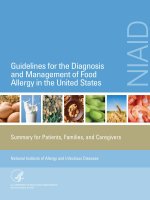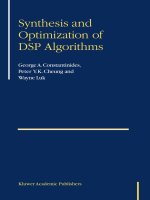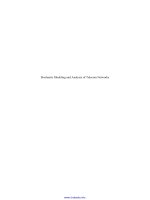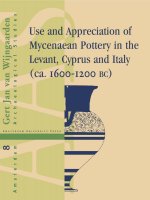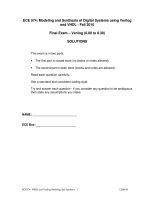Modeling and optimization of gas networks in refinery
Bạn đang xem bản rút gọn của tài liệu. Xem và tải ngay bản đầy đủ của tài liệu tại đây (1.9 MB, 231 trang )
MODELING AND OPTIMIZATION OF GAS NETWORKS IN
REFINERY
ANOOP JAGANNATH
(B.Tech, Anna University, India)
A THESIS SUBMITTED
FOR THE DEGREE OF MASTER OF ENGINEERING
DEPARTMENT OF CHEMICAL AND BIOMOLECULAR ENGINEERING
NATIONAL UNIVERSITY OF SINGAPORE
2012
Acknowledgements
ACKNOWLEDGMENTS
I would like to take this opportunity to extend my sincere thanks to my supervisor
Prof. I. A.Karimi for his continuous guidance and support all throughout my Master
of Engineering program. His constant encouragement, supervision and supportive
nature have served as a driving force for me to complete this project. I am highly
indebted to him for his ideas and recommendations on the project which were
responsible for the success of the same. I am also grateful to him for recommending
me for the Canadian Commonwealth Scholarship Program.
I owe a great deal to Prof. Ali Elkamel for his constant support during my stay in
University of Waterloo, Canada. The technical discussions with him have been
instrumental in shaping the course of this project. I extend my sincere thanks to Dr.
Chandra Mouli R. Madhuranthakam for the technical assistance I received on some
aspects of the project. I am also thankful to the Department of Foreign Trade and
International Affairs, Canada for the financial support during my stay in Canada as a
part of the Canadian Commonwealth Scholarship Program.
I would like to thank Prof. David T. Allen and his graduate student Fahad, for
providing suggestions in improving some aspects of this project.
I express my sincere and deepest gratitude to my family for their love,
encouragement, hope, faith, moral and financial support.
I sincerely thank all my lab mates for sharing their knowledge and experiences, which
has helped me in every aspect of this project. Their valuable insights have played a
crucial part in the success of this project.
ii
Acknowledgements
I am grateful to all my roommates and friends, both in Singapore and Canada, for
always helping me out and supporting me during my troubled times. If not for them,
my graduate student life would not have been so exciting and interesting.
I also thank National University of Singapore for providing me the opportunity to
pursue Master of Engineering course in Singapore.
Last but not the least; I am thankful to the Almighty for providing me the inner
strength and blessing me with the qualities which were needed for the successful
completion of this project.
iii
Table of Contents
TABLE OF CONTENTS
DECLARATION........................................................................................................... i
ACKNOWLEDGMENTS ...........................................................................................ii
SUMMARY ................................................................................................................vii
LIST OF TABLES ...................................................................................................... ix
LIST OF FIGURES ...................................................................................................xii
NOMENCLATURE .................................................................................................. xiv
1
2
INTRODUCTION ................................................................................................ 1
1.1
Refinery Process Network ............................................................................... 1
1.2
Gas Process Network Design-Challenges and Benefits .................................. 6
1.3
Refinery Fuel Gas Network............................................................................. 8
1.4
Refinery Hydrogen Network ......................................................................... 10
1.5
Research Objectives ...................................................................................... 13
1.6
Outline of the thesis....................................................................................... 14
LITERATURE REVIEW .................................................................................. 16
2.1
Network Optimization ................................................................................... 16
2.2
Fuel Gas Network.......................................................................................... 18
2.3
Refinery Hydrogen Network ......................................................................... 22
2.3.1
Hydrogen Sources .................................................................................. 23
2.3.1.1 Steam Methane Reforming................................................................. 24
2.3.1.2 Steam Naphtha Reforming ................................................................. 26
2.3.1.3 Other methods of hydrogen production ............................................. 26
2.3.1.4 Catalytic Reforming ........................................................................... 27
2.3.2
Hydrogen Consumers............................................................................. 27
2.3.2.1 Hydrotreating ..................................................................................... 28
2.3.2.2 Hydrocracking .................................................................................... 29
2.3.3
Purification Units ................................................................................... 30
2.4
Global Optimization ...................................................................................... 36
2.5
Summary of Gaps and Challenges ................................................................ 42
2.6
Research Focus .............................................................................................. 43
3 MODELING AND OPTIMIZATION OF MULTIMODE FUEL GAS
NETWORKS .............................................................................................................. 45
3.1
Introduction ................................................................................................... 45
iv
Table of Contents
3.2
Problem Statement ........................................................................................ 47
3.3
Model Formulation........................................................................................ 51
3.4
Refinery Case Study ...................................................................................... 60
3.4.1
Impact of Multi-mode Model................................................................. 61
3.4.2
Impact of Integration.............................................................................. 70
3.4.3
Impact of Fuel Quality ........................................................................... 71
3.4.4
Impact of Flexible Sinks ........................................................................ 72
3.4.5
Impact of Fuel Quality and Flexible Sinks ............................................ 72
3.5
4
GLOBAL OPTIMIZATION OF HYDROGEN NETWORKS...................... 74
4.1
Introduction ................................................................................................... 74
4.2
Problem Statement ........................................................................................ 75
4.3
Model Formulation........................................................................................ 83
4.3.1
Balance Equations.................................................................................. 83
4.3.2
Flow Connections to/from the Units ...................................................... 89
4.3.3
Bound Strengthening Cut ....................................................................... 91
4.3.4
Comparison to previous work ................................................................ 93
4.4
Convex Relaxation of Bilinear terms ............................................................ 95
4.5
Global Optimization Algorithm .................................................................... 99
4.6
Examples ..................................................................................................... 102
4.6.1
Example 1 ............................................................................................ 103
4.6.2
Example 2 ............................................................................................ 104
4.6.3
Example 3 ............................................................................................ 108
4.6.4
Example 4 ............................................................................................ 108
4.6.5
Example 5 ............................................................................................ 113
4.6.6
Example 6 ............................................................................................ 119
4.7
Computational results.................................................................................. 120
4.8
Optimization of multi-plant/refinery hydrogen networks ........................... 123
4.8.1
Problem Statement ............................................................................... 126
4.8.2
Model Formulation .............................................................................. 129
4.8.3
Case Study ........................................................................................... 139
4.9
5
Conclusion..................................................................................................... 72
Conclusion................................................................................................... 151
IMPROVED SYNTHESIS OF HYDROGEN NETWORKS ....................... 152
v
Table of Contents
5.1
Introduction ................................................................................................. 152
5.2
Problem Statement ...................................................................................... 153
5.3
Model Formulation ...................................................................................... 160
5.3.1
Flow Balances ...................................................................................... 162
5.3.2
Pressures and Temperatures................................................................. 164
5.3.3
Total Annualized Cost (TAC) .............................................................. 166
5.4
5.4.1
Example 1 ............................................................................................ 170
5.4.2
Example 2 ............................................................................................ 176
5.5
6
Examples ..................................................................................................... 168
Conclusion................................................................................................... 182
CONCLUSIONS AND RECOMMENDATIONS ......................................... 183
6.1
Conclusions ................................................................................................. 183
6.2
Recommendations ....................................................................................... 185
6.2.1
Fuel Gas Network ................................................................................ 185
6.2.2
Hydrogen Network............................................................................... 186
REFERENCES ......................................................................................................... 189
List of Publications .................................................................................................. 203
vi
Summary
SUMMARY
The increased cost of crude oil, stringent environmental regulations and ever
increasing demand for energy have made the refineries to adopt a more holistic
approach that seeks to integrate energy, economics and the environment in its design
and operation. One of the attractive options is to systematically utilize all the existing
resources or utilities. Such an option of resource conservation, apart from promoting
sustainable development, also plays a greater role in achieving greater cost savings.
This thesis focuses on the two main utilities in a refinery namely fuel gas and
hydrogen. These (fuel gas and hydrogen) are directly related to the refinery capacity
and revenue and any step taken towards their conservation are certainly desirable and
are of pivotal significance. To understand this, a network approach is adopted which
studies the overall consumption of these utilities/gases in the entire refinery. This
thesis mainly addresses the modeling and optimization of such gas networks in a
refinery. The refinery gas networks considered here are the fuel gas and hydrogen
networks.
First, we study the fuel gas networks. In this work, modeling and optimization of a
multimode fuel gas network is carried out, that serves to operate optimally for all the
modes of the refinery operation. This was studied for a refinery case study and results
showed significant improvement in the capital cost of the network in comparison to
the single mode. Apart from this, using the above model several interesting strategies
for reducing the flaring and environmental penalties in refinery operation is examined.
Next, we deal with the modeling and optimization of hydrogen network in the
refinery. The work on the hydrogen network is divided into two parts. In the first part,
the hydrogen network models available in the literature are generalized and modified
vii
Summary
to be solved to global optimality. Some examples were presented to show the
optimization of hydrogen networks using the proposed global optimization approach.
Results showed that the proposed algorithm showed superior performance when
compared with the available commercial global optimization solver BARON. Next,
this modified model is extended by considering integration with networks in other
plants/refinery. Different integration schemes were proposed, studied and investigated
in this regard. The results showed that the overall hydrogen consumption and total
annualized cost was decreased when the networks were integrated.
In the second part of the work on hydrogen network, a more realistic model for the
hydrogen network was developed. This nonconvex nonlinear programming model for
the improved synthesis of hydrogen network, addressed some shortcomings observed
in the previous existing models of hydrogen network. The model showed the
importance and significance of including non-isothermal conditions on the network
design along with non-isobaric conditions. Various challenges and issues relating to
the same were also explained.
viii
List of Tables
LIST OF TABLES
Table 3.1 Data and Parameters for the sources and sinks in the refinery case study... 62
Table 3.2 CAPEX and OPEX coefficients for various equipment units ..................... 63
Table 3.3 CAPEX ($/MMscf) values for various source-sink pipelines ..................... 63
Table 3.4 Distribution (%) of flows into sinks from sources for various modes in the
Multimode FGN ........................................................................................................... 65
Table 3.5 Distribution (%) of flows into sinks from sources for various modes in the
Base FGN ..................................................................................................................... 66
Table 3.6 Flows and specs into the sinks for various operating modes in the
Multimode FGN ........................................................................................................... 67
Table 3.7 Flows and specs into the sinks for various operating modes in the Base FGN
...................................................................................................................................... 68
Table 3.8 Comparison of CAPEX and OPEX for the Base and Multimode FGN ...... 69
Table 3.9 Impacts of various factors on the performance of refinery FGN ................. 71
Table 4.1 Cost parameters for all examples ............................................................... 103
Table 4.2 Example 1 - Data for existing compressors ............................................... 105
Table 4.3 Example 1 - Operating conditions of processing units .............................. 105
Table 4.4 Example 1 - Data for processing units ....................................................... 105
Table 4.5 Example 2 - Data for existing compressors ............................................... 105
Table 4.6 Example 2 - Operating conditions of processing units .............................. 105
Table 4.7 Example 2 - Data for processing units ....................................................... 106
Table 4.8 Example 3 - Data for existing compressors ............................................... 106
Table 4.9 Example 3 - Data for hydrogen sources..................................................... 106
Table 4.10 Example 3 - Operating conditions of processing unit .............................. 106
Table 4.11 Example 3 - Data for processing units ..................................................... 106
Table 4.12 Example 4 - Data for existing compressors ............................................. 107
Table 4.13 Example 4 - Data for hydrogen sources................................................... 107
Table 4.14 Example 4 - Operating conditions of processing units ............................ 107
ix
List of Tables
Table 4.15 Example 4 - Data for processing units ..................................................... 107
Table 4.16 Example 5 - Data for existing compressors ............................................. 114
Table 4.17 Example 5 - Data for hydrogen sources................................................... 114
Table 4.18 Example 5 - Operating conditions of processing units ............................ 114
Table 4.19 Example 5 - Data for processing units ..................................................... 114
Table 4.20 Example 6 - Data for existing compressors ............................................. 115
Table 4.21 Example 6 - Data for hydrogen sources................................................... 115
Table 4.22 Example 6 - Operating conditions of processing units ............................ 115
Table 4.23 Example 6 - Data for processing units ..................................................... 115
Table 4.24 Model sizes for all examples ................................................................... 120
Table 4.25 Results for examples 1-6.......................................................................... 121
Table 4.26 Comparison study of the effect of cuts on BARON solver ..................... 121
Table 4.27 Data for existing compressors in plant A................................................. 136
Table 4.28 Data for hydrogen sources in plant A ...................................................... 136
Table 4.29 Operating conditions of processing units in plant A................................ 136
Table 4.30 Data for processing units in plant A ........................................................ 136
Table 4.31 Data for existing compressors in plant B ................................................. 137
Table 4.32 Data for hydrogen sources in plant B ...................................................... 137
Table 4.33 Operating conditions of processing units in plant B ................................ 137
Table 4.34 Data for processing units in plant B......................................................... 137
Table 4.35 Data for existing compressors in plant C ................................................. 138
Table 4.36 Data for hydrogen sources in plant C ...................................................... 138
Table 4.37 Operating conditions of processing units in plant C ................................ 138
Table 4.38 Data for processing units in plant C......................................................... 138
Table 4.39 Optimization results for the case study .................................................... 147
x
List of Tables
Table 4.40 Computational results for the case study ................................................. 148
Table 5.1 CAPEX and OPEX for hydrogen network ................................................ 171
Table 5.2 Parameters for the origin units- Example 1 ............................................... 171
Table 5.3 Parameters for the destination units- Example 1 ....................................... 172
Table 5.4 Specific heat (kJ/tonne K) values for various origin destination transfer line
combinations - Example 1 ......................................................................................... 172
Table 5.5 Joule-Thompson coefficient (K/bar) values for various origin destination
transfer line combinations - Example 1 ..................................................................... 172
Table 5.6 Adiabatic compression coefficients values for various origin destination
transfer line combinations- Example 1 ...................................................................... 173
Table 5.7 Parameters for origin units- Example 2 ..................................................... 177
Table 5.8 Parameters for destination units- Example 2 ............................................. 177
Table 5.9 Stream attributes along the transfer line - Example 2................................ 178
Table 5.10 Operating conditions for various units in hydrogen network - Example 1
.................................................................................................................................... 179
Table 5.11 Operating conditions for various units in hydrogen network - Example 2
.................................................................................................................................... 179
Table 5.12 CAPEX and OPEX for all examples ....................................................... 180
xi
List of Figures
LIST OF FIGURES
Figure 1.1 U.S. Oil refinery operating cost distribution ................................................ 7
Figure 1.2 Schematic diagram of fuel gas network in a typical refinery ....................... 9
Figure 1.3 Schematic diagram of a hydrogen network in refinery .............................. 11
Figure 1.4 U.S. refinery hydrogen production capacity............................................... 13
Figure 2.1 Process flow diagram for Steam Methane Reforming Unit ....................... 25
Figure 2.2 Process flow diagram of a Hydrodesulfurization unit ................................ 29
Figure 2.3 Process flow diagram of a Hydrocracking unit .......................................... 30
Figure 3.1 Flow to a typical industrial flare in the HG area ........................................ 46
Figure 3.2 Schematic superstructure for an FGN ........................................................ 51
Figure 3.3 Fuel sources and sinks for the refinery case study ..................................... 61
Figure 3.4 Modes of operation for the refinery case study with relative duration ....... 64
Figure 4.1 Schematic diagram of various units in hydrogen networks (a) Hydrogen
sources (b) Processing units (c) Existing compressors (d) New compressors (e)
Purification units (f) Fuel gas sinks ............................................................................. 79
Figure 4.2 Flowchart for Specialized Outer Approximation algorithm ..................... 101
Figure 4.3 Existing network for example 1 ............................................................... 109
Figure 4.4 Optimal solution for example 1 ................................................................ 109
Figure 4.5 Existing network for example 2 ............................................................... 110
Figure 4.6 Optimal solution for example 2 ................................................................ 110
Figure 4.7 Existing network for example 3 ............................................................... 111
Figure 4.8 Optimal solution for example 3 ................................................................ 111
Figure 4.9 Existing network for example 4 ............................................................... 112
Figure 4.10 Optimal solution for example 4 .............................................................. 112
Figure 4.11 Existing network for example 5 ............................................................. 116
Figure 4.12 Optimal solution for example 5 .............................................................. 116
xii
List of Figures
Figure 4.13 Existing network for example 6 ............................................................. 117
Figure 4.14 Optimal solution for example 6 .............................................................. 118
Figure 4.15 Schematic diagram for direct integration for three plant case ................ 130
Figure 4.16 Schematic diagram for indirect integration for three plant case integrated
by centralized unit ...................................................................................................... 131
Figure 4.17 Schematic diagram for indirect integration for three plant case integrated
directly and also through centralized unit .................................................................. 132
Figure 4.18 Existing networks for plant A, B and C ................................................. 140
Figure 4.19 Optimized network for plant A, B and C individually ........................... 141
Figure 4.20 Optimized network for direct integration ............................................... 142
Figure 4.21 Optimized network for indirect integration scheme 1 ............................ 143
Figure 4.22 Optimized network for indirect integration scheme 2 ............................ 144
Figure 4.23 Optimized network for indirect integration scheme 3 ............................ 145
Figure 5.1 Schematic diagram of different processing units in a hydrogen network. (a)
Hydrogen source (b) Processing unit (c) Purification unit (d) Fuel gas sink............. 154
Figure 5.2 Superstructure of a hydrogen network ..................................................... 161
Figure 5.3 Optimal network for Example 1 ............................................................... 174
Figure 5.4 Optimal network for Example 2 ............................................................... 181
xiii
Nomenclature
NOMENCLATURE
NOTATION
CHAPTER 3
Indices
Fuel sources
Pollutants
Fuel sinks
Period/mode
Specification for fuel gas quality
Parameters
Annualization factor
Capital cost of compressor between source and sink
Capital cost of cooler between source and sink
Capital cost of heater between source and sink
Capital cost of transfer line from source to sink
Capital cost of valve between source and sink
Heat capacity of source in mode
Minimum and maximum energy demand of sink
in mode
Minimum and maximum allowable flow to sink
in mode
Hydrocarbon content (mass / MMscf) of source stream in mode p
Amount of pollutant j that sink k would emit in mode p for one
1 MMscf of fuel gas flared
Hydrocarbon dew point temperature for sink
in mode
Limit on hydrocarbons flared without penalty at flare in mode p
Regulatory limit on pollutants j flared without penalty at flare
in mode p
xiv
Nomenclature
Minimum and maximum lower heating value at sink
Moisture dew point temperature for sink
in mode
in mode
Adiabatic compression coefficient of source in mode
Operating cost of compressor between source and sink
in mode
Operating cost of cooler between source and sink
in mode
Operating cost of heater between source and sink
in mode
Operating cost of transfer line from source to sink
Operating cost of valve between source and sink
in mode
in mode
On-stream time of plant per year
Known pressure of source in mode
Minimum and maximum allowable pressure at sink
in mode
Value of spec for source in mode
Minimum and maximum value of a spec at sink
in mode
Gas constant
Minimum and maximum allowable specific gravity at sink
in mode
Minimum and maximum allowable temperature of source in mode
Known temperature of source in mode
Minimum and maximum allowable temperature at sink
in mode
Reference temperature
Mole fraction of hydrocarbon component in stream in mode
Minimum and maximum value of Wobbe Index at sink
in mode
Cost of source in mode
Revenue from surplus output by flexible sink
in mode
xv
Nomenclature
Penalty ($/mass) for flaring hydrocarbon beyond regulatory limit at
flare in mode
Penalty per unit emission of pollutant during mode
beyond the
regulatory limit
Cost of fuel gas for mode
in sink
Adiabatic compression efficiency of source in mode
Fractional annual duration of mode
Joule – Thompson expansion coefficient of source in mode
Continuous variables
Energy flow into sink
in mode
Capacity of transfer line from source to sink
Flow (MMscf) from source in mode
Flow from source to sink
Flow (MMscf) into sink
in mode
in mode
Heat content of gas stream from source to sink
in mode
Hydrocarbon amount flared beyond regulatory limit at flare in
mode
Pollutant j flared in mode p
Lower heating value at sink
Pressure at sink
in mode
in mode
Specific gravity at sink
Temperature at sink
in mode
in mode
Maximum duty of compressor in transfer line from source to
sink
Maximum duty of cooler in transfer line from source to sink
Maximum duty of heater in transfer line from source to sink
xvi
Nomenclature
Maximum duty of valve in transfer line from source to sink
Product of
and temperature change during compression
in
Product of
and temperature change during cooling
in
Product of
and temperature change during heating
in
Product of
and temperature change during expansion
in
CHAPTER 4
Indices
Hydrogen sources
Fuel gas sinks
Existing compressors
Purification units
New compressors
Refinery /plant
Origin unit
Destination unit
Processing unit
Grid points
Grid points
Sets
Set of origin units
in refinery
Set of new origin units
to be retrofitted
Set of destination unit in refinery
xvii
Nomenclature
Set of new destination units
to be retrofitted
Set of non existing connections from origin
to destination
in
refinery
Parameters
Annualization factor
Operating days of refinery in a year
Cost coefficient of new compressor
Cost coefficient of new compressor
Cost coefficient of purification unit
Cost coefficient of purification unit
Cost coefficient of new pipelines retrofitted
Cost coefficient of new pipelines retrofitted
Cost of gas from hydrogen source
Operating cost of compressors
Revenue generated by burning surplus hydrogen gas in fuel gas sink
Lower heating value of hydrogen gas
Upper bound on flow
Lower bound on flow
Upper bound on pressure difference
Lower bound on pressure difference
Upper bound on compressor power
Lower bound on compressor power
Recovery of purification unit
Maximum capacity of existing compressor
Outlet pressure of existing compressor
Inlet pressure of existing compressor
xviii
Nomenclature
Outlet pressure of new compressor
Inlet pressure of new compressor
Feed flow into processing unit
Flow out of processing unit
Purity required at processing unit
Outlet purity from processing unit
Product stream purity of purification unit
Inlet temperature of the gas stream entering compressor
Specific heat of the gas stream entering compressor
Adiabatic index
Compression efficiency
Length of the interval for variable
Length of the interval for variable
Lower and upper bound on the variable
in bilinear term
Lower and upper bound on the variable
in bilinear term
Binary variables
Existence of pressure difference between origin
Existence of flow between origin
and destination
and destination
Existence of a new compressor
Existence of a new purification unit
Binary variable for incremental cost formulation for variable
in
Binary variable for incremental cost formulation for variable
in
Continuous variables
Flow connecting origin
to destination
xix
Nomenclature
Capacity of the new compressor
Capacity of the purification unit
Flow from source to fuel gas sink
Flow from source to existing compressor
Flow from source to purification unit
Flow from source to new compressor
Flow from source to processing unit
Flow from existing compressor
to fuel gas sink
Flow from existing compressor
to purification unit
Flow from existing compressor
to new compressor
Flow from existing compressor
to processing unit
Flow from purification unit
to existing compressor
Flow from purification unit
to new compressor
Flow from purification unit
to processing unit
Flow from purification unit
to fuel gas sink
Flow from new compressor
to fuel gas sink
Flow from new compressor
to exist compressor
Flow from new compressor
to purification unit
Flow from new compressor
to processing unit
Flow from processing unit
to fuel gas sink
Flow from processing unit
to existing compressor
Flow from processing unit
to purification unit
Flow from processing unit
to new compressor
Flow from processing unit
to other processing unit
Flow from other processing unit
to processing unit
Flow of gas from source
xx
Nomenclature
Flow into the fuel gas system
Pressure at origin unit
Pressure at destination unit
Power consumption of existing compressor
Power consumed by the new compressor
Purity at the existing compressor
Purity into the fuel gas system
Purity out of the source
Purity at the new compressor
Purity of the residue stream from purification unit
Continuous variable
in
grid point
Continuous variable
in
grid point
Local continuous variable in
grid point
Local continuous variable in
grid point
Continuous variable in
grid point
Continuous variable in
grid point
Continuous variable at
and
grid point
CHAPTER 5
Indices
Hydrogen sources
Fuel gas sinks
Processing units
Purification units
Origin unit
Destination unit
xxi
Nomenclature
Parameters
Annualization factor
Capital cost coefficient for purification unit
Operational cost coefficient for purification unit
Specific heat of gas stream in transfer line
connecting origin
to destination
Capital cost coefficient of compressor in transfer line connecting
origin
to destination
Capital cost coefficient of cooler in transfer line connecting
origin
to destination
Capital cost coefficient of heater in transfer line connecting origin
to destination
Capital cost coefficient of pipeline connecting origin
to destination
Capital cost coefficient of valve in transfer line connecting origin
to destination
Cost coefficient of hydrogen gas from source
Minimum and maximum flow of gas from source
Minimum and maximum flow of gas entering processing unit
Adiabatic compression coefficient of gas stream in transfer line
connecting origin
to destination
Operating hours of a refinery in a year
Operational cost coefficient of compressor in transfer line
connecting origin
to destination
Operational cost coefficient of cooler in transfer line connecting
origin
to destination
xxii
Nomenclature
Operational cost coefficient of heater in transfer line connecting
origin
to destination
Operational cost coefficient of pipeline connecting origin
to destination
Operational cost coefficient of valve in transfer line connecting
origin
to destination
Minimum and maximum pressure limits of origin
Minimum and maximum pressure limits of destination
Recovery of hydrogen in purification unit
Minimum and maximum temperature limits of origin
Minimum and maximum temperature limits of destination
Minimum and maximum temperature limits of in transfer line
connecting origin
to destination
Minimum limit on the purity of feed entering processing unit
Minimum and maximum limit on purity of gas into fuel sink
Known purity of hydrogen stream exiting processing unit
Known purity of hydrogen stream from purification unit
Weight fraction of hydrogen in the supply from source
Fraction of hydrogen that leaves with the hydrogen stream exiting
processing unit
Economic value or surplus revenue generated by using hydrogen in
fuel gas sink
Cost coefficient for using /running a fuel gas sink
Joule-Thompson coefficient of gas stream in transfer line
connecting origin
to destination
xxiii


